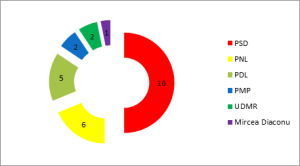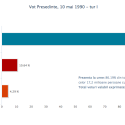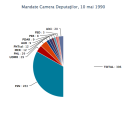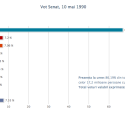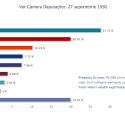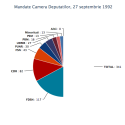IMPORTANT DEVELOPMENTS
- EP ELECTIONS. The Left is stable, consolidated and on a rising trend.
- political dynamics. Victor Ponta remains the favorite for the presidential elections.
- FOREIGN POLICY. Increased focus on the US relations.
- european parliament. A divided European Parliament and a divided Europe.
The Left is stable, consolidated and on a rising trend
The European Parliament elections confirmed once more the Left’s electoral force, political domination, and governmental evolution. The clear victory of the PSD-UNPR-PC alliance is shown not only by the electoral score (37.6%), but also distance ahead of its competitors (the PNL, who came in second, is 22.6% away. The Left’s (PSD) position is consolidated also by a less visible reality, which is nevertheless shown by the electoral profiles. A closer look at independent candidate Mircea Diaconu’s voters’ profile shows that these are largely PSD voters – hence, in reality, the PSD’s score could stand well off the 40% mark.
The PSD’s voters dominant characteristics: pensioners, primary and secondary education, coming from the rural areas in Moldova, Muntenia, and Oltenia. The urban vote ration has decreased, compared to previous polls, but to the same extent that the votes for Diaconu increased. Hence, a part of the young or urban voters of the PSD has voted for Diaconu. Diaconu’s voters have a complementary profile: urban, higher education graduates, middle-aged, women. 75% of Diaconu’s voters state in the polls that they will vote for Victor Ponta in the upcoming presidential elections.
In a politically favorable context (a divided opposition), the PSD has obtained its largest historical electoral score. It is important to notice that this performance occurs after the party has been in power for two years. The most important element on the left wing of the political scene is nevertheless the political stability: there are no frictions, no major political conflicts, and there is a major coordination between action and public communication. The Left’s solid position was also confirmed by the last vote of no confidence in the Parliament (27 May): the Government did not experience any emotions, as the number of votes against the government (176) was smaller than the number of MPs that had voted for calling a no confidence vote in the first place (in order for the vote to pass, 286 favorable votes were needed).
The Left’s victory places the PSD in the pole position for the presidential elections. Although the electoral results force the right-wing forces to regroup, the PSD’s perspectives are favorable for two reasons: on the one hand the social-democrats, will benefit from rising voting intentions, as a result of the psychological conformity mechanism that sets in favor of the winner after every round of elections; on the other hand, the PSD can count on the effects of a series of positive economic results, that can help strengthen the public perception of the Government’s economic and political acumen.
The result of the elections for the European Parliament has brought the representatives of the Romanian right-wing parties (the actors that define themselves as being right wing and who are perceived as such by the public) with their backs against the wall. Lacking a consensual approach and a cooperation project, the upcoming presidential elections highlight a potential failure. Faced with this perspective, but also in order to mask the poor electoral results, the PNL and the PDL made a first step in the direction of “Right’s unification”. Insofar however, this step is more rather a purely rhetorical one, as the existing barriers are hard to overcome.
The alliance between the PNL and the PDL represents an attempt to re-launch the two parties, to overcome the unfavorable post-electoral moment (a categorical defeat), to distract attention from the PSD’s (and largely Mircea Diaconu’s) victory and to take the leadership in coalescing the opposition’s forces. From this point of view, the move is an attack to Traian Basescu, the man who has stimulated the division of the right-wing forces, in order to assume the position of unifying leader. Nevertheless, the president remains a major player; both for the Left (for whom he is the main antagonist) and for the Right (his votes are important for any project on the right side of the political scene).
Moreover, the PDL seems unwilling to severe its relationship with Basescu, but obtains, via these elections, a strengthened negotiation position. At the same time, the liberal leaders (both Iohannis and Antonescu) have repeatedly sent signals that they want to get close to Basescu and his electorate. Regardless of the name of the future PNL leader, this tendency will get stronger, as the presidential elections get closer.
The main obstacle between the PNL and the PDL, on the one hand, and Traian Basescu, on the other, is Elena Udrea. The elections for the European Parliament have confirmed once more that Udrea is incapable of serving as an electoral leader.
The PNL and the PDL have expressed their intention to ally and, on the longer run, to fusion, but beyond the public statements, there are a series of obstacles that need to be overcome:
- The PNL’s tradition and brand, to whom the liberal seem unwilling to renounce that easily;
- The discontent of several PDL leading figures, that do not support the isolation of Traian Basescu on the political scene;
- The discontent of PNL leaders who are not consulted and who see that the party’s faith is decided by an interim leader;
- The candidate for the presidency, given the unlikely chances for a successful presidential bid, will effectively take advantage of the support of only one party (the one who nominates the candidate); politically, any construction on the right side of the political scene, as well as a successful presidential bid, will have a decreased relevance if changing the parliamentary majority proves unsuccessful (in fact, this is the real political target of the opposition).
Currently, the only certainty concerning the unification of the Right is that nothing whatsoever is certain. The perspective of joining all the opposition parties within a single structure remains highly problematic. For the moment, the most likely scenario is that of a bipolar distribution of power o the right side of the political scene, which could come closer in the proximity of the presidential elections (or after the first round of voting): the PNL/PDL one, which has increased political and electoral resources, and Traian Basescu/PMP’s pole, with an increased media and institutional advantage.
The electoral rise and the election to the EP of representatives of parties such as France’s National Front, Syriza (radical left) and Golden Dawns (extreme right) in Greece, UKIP in the United Kingdom, Jobbik in Hungary, the Freedom Party in Austria, the PVV in The Netherlands, have rekindled the European debates on extremism, populism and jingoism in the political space. The votes for these parties, either programmatically or only speculatively Eurosceptic, is generally considered an anti-system vote.
Romania has not experiences such a vote, given that the mainstream political offer promoted by the media did not envisage Eurosceptic or populist parties. Moreover, according to the 415 special Euro barometer “Europe in 2014”, Romania is the country whose citizens trust the EU mostly (58%), alongside Estonia. In comparison 81% of the Greek citizens, 67% of the Spanish, and 63% of the French citizens do not trust the EU.
This reality is reflected at the political level. The main Romanian political parties are pro-European, and nationalism, Eurosceptiscism and extremism represent a socially and politically insignificant trend.
However, there was talk in the Romanian political space of an anti-system vote, understood as an anti-establishment attitude, as a rejection of the political class and of the mainstream political parties. The arguments of the observers supporting this interpretation are based on the large number of votes received by the independent candidate, Mircea Diaconu (6.8%), and of the large number of invalid ballots (5.7%).
Definitely, Diaconu represents “a political phenomenon”, and he has also managed to attract the votes of the undecided voters, who were not convinced by the offers of the major political parties, especially since the electoral turnout was significantly larger than in the previous EP elections (32.16% in 2014 compared to 27,67% in 2009). Nevertheless, a consistent part of his votes come from PSD voters.
As to the invalid ballots, these must be analyzed considering the electoral context. In 2009, against the background of a profoundly apathetic electoral campaign, 194,626 invalid ballots were cast. In 2014, after a quasi-presidential electoral campaign, which was heavily influenced by domestic issues (such as the divisive figure of President Traian Basescu), the number of invalid ballots reached the 321,579 figure. The most relevant comparison factor is the 2012 general elections, when the number of invalid ballots was 283,653, close to the 2014 figure.
As long as the Romanian society will continue to see in the EU a source of welfare and a guarantee of the country’s political direction, the Eurosceptic message will not find any adherents. Consequently, the political actors will strive to stay away from this kind of political discourse, due to its inability to deliver success at the poles.
Victor Ponta remains the favorite for the presidential elections
The European Parliament elections mark PSD’s largest score in history. By achieving to get 37.6% of the final score, PSD has surpassed its 2004 election scores and marking its return as the most important political party in Romania by far. In recent years, though PSD had generally kept a score over 30%, it was closely followed by PDL, which has seen a very steep fall in recent years, managing to only get 12% of the vote for these elections.
In recent elections, PSD gets 16 of the 32 European Parliament seats. Though PSD received 37.6% of the votes, the redistribution of invalidated ballots and votes for parties under the 5% electoral threshold show PSD getting 50% of the seats attributed to Romania in the European Parliament.
PNL misses its target of 20% in the EP elections and the party is now facing a leadership struggle. PNL’s final score only reached 15%, very far behind 20-25%, the score they had initially projected to get in these elections. Figures actually show that PNL was successful in mobilizing its core voters, but the main problem was that there weren’t enough of them left.
| Total votes cast for 2014 EP | |
| PSD | 2093.234 |
| PNL | 835.531 |
| PDL | 680.853 |
| PMP | 345.973 |
| UDMR | 350.689 |
| Mircea Diaconu | 379.582 |
| Others | 880.921 |
| Invalidated | 345.011 |
| Total votes cast | 5.911.794 |
| Total votes possible | 18.221.061 |
Mircea Diaconu, independent candidate, formerly of PNL, gets more votes than required to win EP mandate. Diaconu received 6.8% of the votes cast when 3.4% would have been enough for him to gain an EP seat. Although his score would seem to drained votes from PNL, deeper analysis shows most of his votes would have gone to PSD had he not ran.
In the EP elections, PSD gets a higher score than PNL+PDL+PMP. All three of the main center-right political parties of Romania have received 33% of the vote, while PSD has received 37%. From this perspective, PSD seems to be the favorite for the upcoming presidential elections, even if the three center-right political parties decide to form an alliance.
Victor Ponta is still the most trusted main political leader of Romania, though PNL’s next leader might come close. Victor Ponta’s trust numbers are still high, at around 40% of the total population, though two years of governing have taken a toll on his scores, previously at 45-48% of the total population. Klaus Iohannis, potential next leader of PNL, has an aggregated score of 43%, though that score might prove untenable once Iohannis would start taking political position of behalf of PNL.
Crin Antonescu has exhausted his electoral potential and is now below Traian Băsescu. Crin Antonescu has suffered a very steep fall from the graces of the electorate, tumbling from 44% of the population’s trust, at his highest, to 18% of the population’s trust at this moment. This fall underpins the fragility of the electoral support garnered by a leader of a small party, such as PNL.
Klaus Iohannis and Călin Popescu Tăriceanu seem to have a strong showing, but both are in positions without any political pressure. Any change of leadership status involving either of two would probably decrease their score rapidly, especially if such a change would demand a more confrontational manner of political communication. As they had time to hide from political attention and keep away from conflict, the two also have moderate scores for extreme distrust.
Traian Basescu is still the most violently rejected political in Romania, while Crin Antonescu is close behind. Such high levels of extreme distrust are hazardous for any political competition the two would be tempted to participate in. Victor Ponta’s extreme distrust figures are also somewhat elevated, but still far behind the first two. Considering the two years of leading Government, Ponta’s scores are quite favorable.
PNL’s potential next leader, Klaus Iohannis, is squarely in the middle of two electorates at this point. One electorate is the former USL electorate, close to Victor Ponta and Crin Antonescu and the other electorate is the center-right electorate, close to Emil Boc, Traian Basescu and Mihai Razvan Ungureanu. When he does come to power, Iohannis will be forced to choose between the two electorates and will inevitably lose one of them.
The potential allegiance between PNL and PDL would still depend on Traian Basescu’s followers. The biggest issue of the potential alliance between the two main center-right parties is the fact that PNL supporters still do not like Traian Basescu, but PNL + PDL is a long way from coming close to PSD’s electoral potential.
Mr. Ponta would still win against any opponent in a presidential second round. PSD’s Victor Ponta would win handily against all of announced candidates for the presidency. His tightest score, though still enough for a handy victory, would be against PNL potential next leader, Klaus Iohannis.
Klaus Iohannis would garner higher scores than most current center-right candidates, but would still lose. The mayor of Sibiu would get a better score against potential PSD candidates, but he would still lose against almost any of the names currently circulated to run.
The left is in a very good position to win the presidential elections. The table below shows a distribution of the politically active population and their voting intentions. Blue represents the people who will vote for any center-right candidate, red represents the people who will vote for a PSD candidate, namely Victor Ponta, no matter who is running against him and light red are people who would vote for Victor Ponta depending on who will run against him.
PSD’s electorate is mostly older and less educated. As can be seen from the table, it’s the elderly and the less educated that are the most active Victor Ponta voters in Romania. The voting structure has flattened in recent years, as PSD is quickly recovering within the younger, urban voting cohort, especially in Bucharest, where the table shows PSD has surpassed the center-right parties.
Increased focus on the US relations
The recent American interest in the region brings Romania closer to the US. Hagel’s and Biden’s high profile visits, as well as Obama’s message of support for Romania has the effect of increasing Romania’s staunchly pro-American position in the region. The immediate effect is the Romanian political class will refrain from any move that will be seen as contrary to American interests.
Romania will invest in the defense sector. Russia’s actions in the region have prompted major security concerns for Romania, a country that has been tempted to free-ride on the US security guarantees and on its NATO membership. The bold Russian actions in Ukraine have been met with major concerns and it is likely that Romania will focus on spending at least 2% of its GDP on defense (a major increase).
Romania will seek to bolster its security guarantees. Insisting on drawing a major NATO contingency plan (a plan dealing with prospective hostile attacks against the country, a courtesy only Poland and the Baltics have enjoyed) is a major step taken by Romania in this direction. Increased cooperation with Poland and strong support for Ukraine are the expected moves in Romanian foreign policy.
The Romanian security, foreign policy and governmental establishment has seen the recent Russian moves as an additional argument for aligning the country with the US. The bureaucratic pressure will undoubtedly force the Romanian political forces into an impromptu competition for the position of the most US friendly political force. Institutionally, Romania will press for an increased presence of the US in Romania, as well as for closer links with Poland and an strong support for Kiev. Within NATO, Romania will be a strong voice for bolstering the Alliance’s Eastern Europe presence, as well as a profoundly Russia-hostile voice.
A divided European parliament and a divided europe
The European elections do not represent a major break with EP elections. Historically, Eurosceptic or marginal political parties polled better than expected in the European Parliament elections. Due to the lack of importance attached to the European Parliament Historically, Eurosceptic or marginal political parties polled better than expected in the European Parliament elections or due to restrictive electoral rules for general elections, as well as the insistence of the European institutions on proportional representation in the EP, Eurosceptic, populist, nationalist an even Nazi parties have managed to gain representation in the EP. The 2014 moment is not different in this respect. What remains to be determined is whether the victory of these forces will add momentum to their political progress (traditionally, anti-system political forces suffer drastic setbacks after successful EP campaigns).
What has changed is the fact that mainstream political forces have let the public agenda be influenced by extremist and populist forces. The fact that mainstream political actors, such as the British Conservatives, the German CDU or the French socialists have taken over the Eurosceptic message (especially in regards to the freedom of movement principle), represents the main victory scored by the Eurosceptic parties. It is difficult nevertheless o envisage whether the newfound agenda of the European political mainstream will lead to amending the core treaties upon which the EU is founded upon.
The EPP remains the EP’s largest force. Their plurality has nevertheless been eroded. Their 221 MEP are 53 fewer than 5 years ago, while their share of the vote has dwindled by 7%. The Socialists remain the EP’s second largest group, with 190 MEPs (and a score smaller by only 1%, compared to the 2009 elections). The liberals remain with only 65 MEPs (18 fewer than 5 years ago), while the Greens will have only 52 MEPs. The Conservative faction has managed to lose only 2 seats but has recorded several small parties joining the group and the EP for the first time, giving the British Conservatives an increased air of legitimacy and somewhat limiting their impression of a solitary EP actor). The Radical Left has increased its numbers. The most important movements occur at the right of the political scene, where two different groups seem to be coagulating – one around the UKIP and the other around the FN.
The Eurosceptic parties are divided. The mutual hostility between Le Pen and Farage, surrounding the positions of the two forces severely hampers the impact the Eurosceptic forces could have at the European level. Several observers have predicted that the Eurosceptic parties will spend more time fighting each other for the position of EP Eurosceptic informal leader.
The EC President position is up for grabs. In spite of the lukewarm support, Merkel has voiced for the EPP candidate, Jean-Claude Juncker, the opposition of Sweden, Hungary and especially that of David Cameron makes his nomination still under doubt. Juncker is supported by the largest forces in the EP (and by the liberals and the extreme left as well). Whether the British PM is willing to make a stand in rejecting his nomination and precipitating an exit referendum remains to be seen. The nomination is nevertheless the hottest European issue.
The new European Parliament will have its share of extreme or radical actors, slightly bigger than it normally does. The main political effect is whether their rise will trigger major institutional and political changes in the European treaties. On a short term, the Council and institutional debates between the different countries and the European institutions will focus on finding a successor to Barroso.


